Patriot Relics
Silver Member
- Feb 6, 2014
- 3,709
- 5,615
- 🥇 Banner finds
- 5
- Detector(s) used
- CTX-3030, Deus XP II
- Primary Interest:
- Relic Hunting
Hey guys,
Had an opportunity to hit a 17th century ship building site turned late 18th century wharf on the last few low tides. This site in completely under the radar as it is only accessible on an ultra low tide.
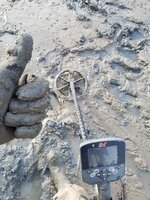
Very little of the original piers remain, but the pluff mud is hiding a massive brick deposit. In the past the site has turned up a pair of cobs, poker chips, and dozens of copper nails. As I worked my way through the nails, I started digging tons of assorted lead pieces. It wasn't until this piece came out that I put 2 and 2 together.
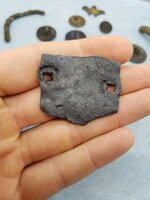
I was recovering sections of a ship's lead sheathing. When lead sheathing was used, it was attached to the ship's hull with copper or gilt nails, usually over an insulating layer of paper or cloth. This suggests strongly that the
corrosive effect of lead on iron, which finally forced the discontinuance of lead sheathing altogether, was recognized even then. In spite of its corrosive action, lead sheathing was perhaps the material most frequently tried for the protection of ship bottoms prior to the 18th century.
All this effort to protect the ships hull from worms...likely from a ship that was constructed in the 17th century!
All in all I ended up with an entire 5 gallon bucket full of it.
Continued hunting produced a late 17th century pewter button, with a welded seam.
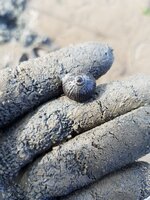
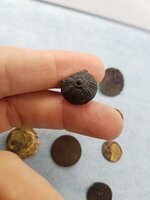
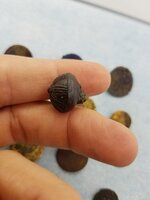
Also a few other intricate copper varieties
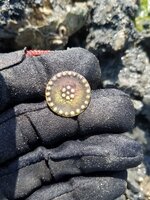
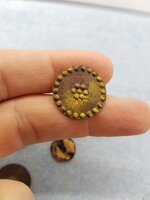
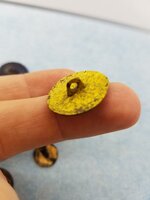
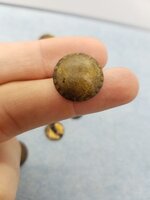
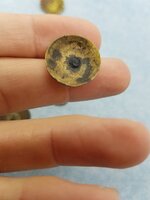
After the lead was cleared, no problems finding the workers buttons
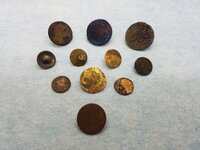
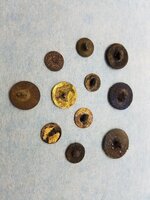
Also managed a shoe buckle fragment
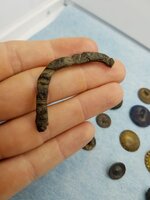
Pewter spoon handle
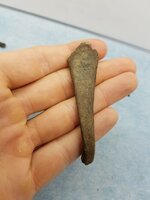
And sightly inland a portion of andiron leg
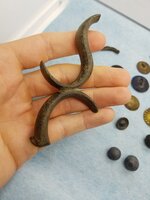
My favorite relics...of course buttons
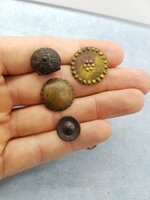
Not to shabby for a few hunts in the muck- happy to save a few pieces lowcountry history. Thanks for looking and good luck out there
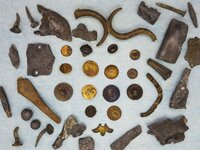
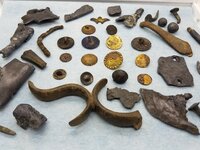
Had an opportunity to hit a 17th century ship building site turned late 18th century wharf on the last few low tides. This site in completely under the radar as it is only accessible on an ultra low tide.

Very little of the original piers remain, but the pluff mud is hiding a massive brick deposit. In the past the site has turned up a pair of cobs, poker chips, and dozens of copper nails. As I worked my way through the nails, I started digging tons of assorted lead pieces. It wasn't until this piece came out that I put 2 and 2 together.

I was recovering sections of a ship's lead sheathing. When lead sheathing was used, it was attached to the ship's hull with copper or gilt nails, usually over an insulating layer of paper or cloth. This suggests strongly that the
corrosive effect of lead on iron, which finally forced the discontinuance of lead sheathing altogether, was recognized even then. In spite of its corrosive action, lead sheathing was perhaps the material most frequently tried for the protection of ship bottoms prior to the 18th century.
All this effort to protect the ships hull from worms...likely from a ship that was constructed in the 17th century!
All in all I ended up with an entire 5 gallon bucket full of it.
Continued hunting produced a late 17th century pewter button, with a welded seam.



Also a few other intricate copper varieties





After the lead was cleared, no problems finding the workers buttons


Also managed a shoe buckle fragment

Pewter spoon handle

And sightly inland a portion of andiron leg

My favorite relics...of course buttons

Not to shabby for a few hunts in the muck- happy to save a few pieces lowcountry history. Thanks for looking and good luck out there


Amazon Forum Fav 👍
Upvote
45










